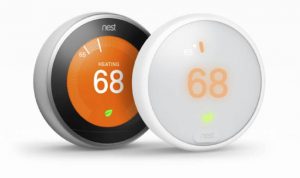
In the spirit of the holidays, we at Haas & Sons wanted to share some tips with you about how you can reduce your electrical usage (and spending) during the winter months. In this day of age where energy efficient products are being released left and right, we feel it’s a good time to learn what could be contributing to your high electric bills and what you can do to remedy that waste. Some of these are easy fixes that you can do yourself and others might require you to call an electrician in Anne Arundel County like us. Whatever path you decide, these tips will help you.
The Benefits of a Programmable Thermostat
Your thermostat is your central nervous system of your home’s heating and cooling systems. In the winter, when there are significant disparities between the inside and outside temperatures, having an older thermostat that isn’t digitally programmable can waste your heat (and money) quickly. Believe it or not, even homes built 10 years ago might not have a programmable unit, so the number of homes that could benefit from retrofitting a new one in its place is high. One thing to note before you go on this adventure is to make sure your existing wiring is compatible with a new unit. You can learn more about this step by reading the Smart Thermostat Guide or you’re welcome to call us to check it for you. Either way, in addition to allowing you to program your internal temperature to the exact specifications you desire, programmable thermostats also provide support for your schedule that allow your home to operate like a well-oiled machine.
Don’t Stray More Than Five Degrees from Your Ideal Settings
Having a programmable thermostat is great, but knowing how to maximize the efficiency of it is even better! Our first tip is to not alter your temperature settings more than 5 degrees from your ideal temperature. As an example, if you find yourself liking 70°F as a consistent temperature, don’t lower your interior temperature below 65°F or raise it above 75°F. The reason behind this suggestion is due to the time it takes your interior space to change from its current temperature, which usually takes a couple of hours to alter it by 5 degrees. Oftentimes, homeowners believe they’re being wise by lowering their heat significantly while they’re gone to work, which makes sense in theory, but is different in practice. By dropping or actually turning off your heat while you’re away, your heating system will be forced to work overtime to get your dwelling to the desired temperature. Had you installed a programmable thermostat instead, your system could periodically adjust your temperature and be much more efficient.
Adjust Your Temperature 1 Hour Prior to Needing it Warm
Another tip for efficiency is to program your thermostat to adjust the heat in your home one hour prior to arriving back or prior to a gathering. As an example, if you plan to arrive home and host friends for dinner at 6PM and you’d like the temperature to a cozy 75°F, we recommend that you program your settings to begin heating at 5PM. Since you’re already taking our first tip to heart and your thermostat is within 5°F of the desired temperature, this hour will be plenty of time to warm your home for your guests and event.
When Should Your Thermostat Heat Your Home?
At the Haas household, we have a schedule in the winter that has worked for many years and I think it likely could work for you as well (albeit with a tweak here or there).
- Wake-Up: We get up at 5:30AM, so our thermostat is set to turn on at 4:30AM and slowly increase the heat to our desired setting. Once all of us are ready to leave the house around 8AM the heat stops.
- Away for Work: While away our thermostat simmers and keeps the home within 5°F of our desired temperature. Most likely the system only turns on intermittently to adjust the climate ever so slightly, so the “waste” is minimal.
- Arrive Home: We usually get home at 6PM, so at 5PM I have the system begin to heat. This is done easily because the interior temperature is within the desired range, so we usually come home to a perfectly comfortable home.
- Bedtime: While no one likes to sleep in a sauna nor an icebox, most households can lower their thermostat settings a bit while they sleep. Between sharing a bed with a partner and adding materials like down-feather duvets, your bedding can keep you quite warm. It’s because of this that we lower our temperature 5°F while we sleep and you can then see why the system needs to heat up again in the morning to start the cycle from top to bottom all over again.
The Best Programmable Thermostats for 2025
If you’ve read our Haas & Son’s blog before you know we like to suggest products that we install often in our customers’ homes and have learned to enjoy their consistency and quality. Like all things, these recommendations will come with varying features and price tags.
Nest:
Nest has done a great job of bringing ‘smart technology’ to the home and they’ve done so with an innovative and handsome design. Nest offers two different thermostats that vary from $169 to $249 depending on what features you’re looking for (these can be purchased for less at Amazon from time to time). In addition to Nest’s enjoyable user-interface and aesthetics, it really is an all-inclusive product that does an exceptional job at not only being a thermostat, but also providing you with a type of virtual assistant in your home’s efficiency (particularly with their Learning Thermostat). All Nest products come with access to the Nest app, so you can control your home’s settings from anywhere. For the interior designer within you, you’ll be happy to know Nest comes with 7 different materials for the unit’s housing, which allow for the unit to seamlessly integrate into any design element. That said, there is a drawback to Nest and that’s largely tied to their Nest Aware feature, which will cost homeowners who elect that option an additional $10 per month.
ecobee:
ecobee (it’s meant to be all lowercase) is a similar option for the consumer who still wants a top-tier smart thermostat, but aren’t fond of the Nest. The two virtually do the same things, but with different presentations and user-interfaces. Equally similar, the pricing is identical at $169 to $249 depending on what features you purchase (Amazon also sells them at a discount from time to time). Unfortunately, the ecobee only comes in their black mirror finish, so you won’t have as many design choices here. The one benefit to ecobee, compared to Nest, is that there isn’t a monthly subscription fee, so you don’t have recurring expenses.
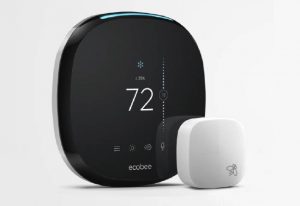
Emerson:
Emerson offers, what I consider to be, a fantastic programmable thermostat without all the connectivity option that many households don’t require or want. While having a hyper-contemporary thermostat like the Nest or ecobee is fun and will save you money on your electric bill, an Emerson thermostat is just as useful. Emerson has been around forever and has a really reputable name in the industry. Probably the best option with the Emerson product line is their pricing. Their top-tier unit sells for the same as the base unit of the competitors and the majority of their products can be purchased for well under $100 (some are even below $50). For many of us, particularly those of us who didn’t grow up connected to technology, the Emerson unit will also be the one that has the easiest learning curve and will “feel most familiar” than the others. Lastly, it has no subscription costs.

Other Tips Unrelated to Your Thermostat
While we believe that most households will see their most immediate and effortless benefits with converting to a programmable thermostat, there are several other things to check for this season. These vary from forgetting to turn a switch off to structural issues, so these solutions will likely have you running around your house temporarily checking the list.
How’s the Insulation in Your Attic?
The standards of what type of insulation and how much of it you have varied by who built your home and when. In an ideal situation, you’d invest in spray foam insulation, which does a great job of sealing your attic from the living space and outside. That said, spray foam is pricey and some homeowners don’t see the need for it. Traditional fiberglass insulation is still a great route, but you need to make sure you have it at a depth of between 15” and 18”.
Here in Maryland, we are what’s considered a thermal resistance (R-value) of 4 (very close to a 5). The R-Value is a way to classify your home’s region with regards to the environmental temperatures and climate that should be expected for that region. R-values go from 1 to 8, so having a nearly 5 rating shows we should expect it to be quite cold here, which is why we recommend the 16”-18” of insulation (this can be purchased by searching for ‘R49 insulation’). You can learn more about insulation depths and R-values by visiting the Insulation Institute website here.
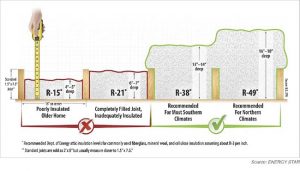
Do You Have Any Drafts?
Depending on when your home was built, you could have experienced foundational setting since then or a wealth of other factors that could have created openings to the outside elements. Oftentimes these will be seen in door jams, so that’s where we encourage customers to look first. One trick that can work pretty effortlessly is to check if you can see light coming below your door or around it. In its proper configuration a door shouldn’t allow for any light to seep past it, so if you see something like the below photo, you’ll want to invest in new weather stripping (around the door) and door sweeps (below the door). Weather stripping and door sweeps close those gaps, which act like vacuums stealing your warm air out and vice versa. They’re really inexpensive and easy to DIY, so have at it and seal your home up!
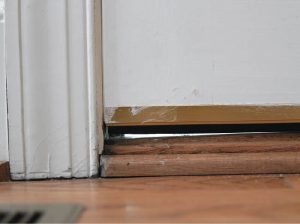
Do You Use Space Heaters?
I get it, I really do, space heaters feel amazing in a cold office and it makes sense why people use them. That being said, they really are a strain on your electrical system and if left unmonitored they can contribute to fire risks. It’s because of this that we don’t recommend their use, particularly in homes with old or suspect wiring, but to really drive the point home a little further, I wanted to share a photo with you. Below is a thermal imaging scan of some electrical connections. As you can see, there are two that are functioning normally, but one is glowing red aggressively. This is because of what’s called resistance heat, which occurs when a person is overworking their system. This is what can happen to your electrical system if you’re using a space heater, so if you’re using one regularly, I’d suggest stopping and checking to see how much your electricity bill went down.
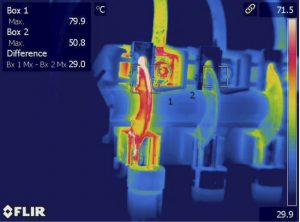
Final Consideration
Before we close this post, I wanted to share a final contributor to be on the lookout for if your electricity bill is higher than usual. One scenario I’ve encountered on multiple occasions is when a customer calls me out to their home because they’re experiencing an unusually high electric bill in the neighborhood of $500-700 per month. Almost always it’s due to an electrical heat pump being left in their ‘emergency heat’ setting. Heat pumps work like an air conditioner, but in reverse, in the sense that they make warm air that blows out in the upper 80°F. When a heat pump is left in emergency heat mode (compared to standard heat mode) it will always have a blower element running concurrently. This blower is meant to rapidly fill a home with heat in a said emergency, but the problem is that these units have 3 elements within them that are large enough to run a full-size water heater on their own. So if you accidentally triggered your emergency setting on your pump, each time it’s warming your home you’re essentially powering 3 water heaters at once. This is highly inefficient and wasteful, so I recommend making sure that switch is in the off position each year.
